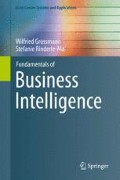Abstract
In this chapter, we present analysis techniques for temporal data. First of all, we discuss the different data structures in temporal mining, introduce the different analytical goals and models, and give an overview on the corresponding analytical techniques subsequently. Section 6.2 considers time warping and response feature analysis for clustering and classification, Sect. 6.3 discusses regression models and their role in predicting the time period until the occurrence of an event, and Sect. 6.4 introduces the analysis of Markov chains. The following sections deal with analysis techniques for temporal patterns, in particular association analysis, sequence mining, and episode mining.
Access this chapter
Tax calculation will be finalised at checkout
Purchases are for personal use only
Preview
Unable to display preview. Download preview PDF.
References
Agrawal R, Srikant R (1994) Fast algorithms for mining association rules. In: Bocca JB, Jarke M, Zaniolo C (eds) VLDB’94: International conference on very large databases. Morgan Kaufmann, San Francisco, pp 487–499
Agrawal R, Srikant R (1995) Mining sequential patterns. In: Yu PS, Chen ALP (eds) ICDE’95: International conference on data engineering. IEEE, Los Alamitos, California, Washington, Tokyo, pp 3–14
Agrawal R, Imielinski T, Swami A (1993) Mining association rules between sets of items in large databases. ACM SIGMOD Rec 22(2):207–216
Antunes CM, Oliveira AL (2001) Temporal data mining: an overview. In: KDD workshop on temporal data mining, pp 1–13
Baldi P, Frasconi P, Smyth P (2003) Modeling the internet and the web: probabilistic methods and algorithms. Wiley, New York
Bishop CM (2006) Pattern recognition and machine learning. Springer, New York
Brosrtöm G (2012) Event history analysis with R. CRC, Boca Raton
Everitt BS, Hothorn T (2006) A handbook of statistical analysis using R. Chapman & Hall/CRC, New York
Ferreira DR, Gillblad D (2009) Discovering process models from unlabelled event logs. In: Dayal U, Eder J, Koehler J, Reijers HA (eds) BPM’09: international conference on business process management. Lecture notes in computer science, vol 5701. Springer, Heidelberg, pp 143–158
Giorgino T (2009) Computing and visualizing dynamic time warping alignments in R: the dtw package. J Stat Softw 31(7):1–24
Hamilton JD (1994) Time series analysis (2). Princeton University Press, Princeton
Hipp J, Güntzer U, Nakhaeizadeh G (2000) Algorithms for association rule mining—a general survey and comparison. ACM SIGKDD Explor Newslett 2(1):58–64
Julisch K, Dacier M (2002) Mining intrusion detection alarms for actionable knowledge. In: ACM SIGKDD international conference on knowledge discovery and data mining. ACM, New York, pp 366–375
Killick R, Fearnhead P, Eckley IA (2012) Optimal detection of changepoints with a linear computational cost. JASA 107(500):1590–1598
Laxman S, Sastry PS (2006) A survey of temporal data mining. Sadhana 31(2):173–198
Mabroukeh NR, Ezeife CI (2010) A taxonomy of sequential pattern mining algorithms. ACM Comput Surv 43(1):3
Mannila H, Toivonen H, Verkamo IA (1997) Discovery of frequent episodes in event sequences. Data Min Knowl Discov 1(3):259–289
Mitsa T (2010) Temporal data mining, CRC, Boca Raton
Müller M (2007) Dynamic time warping. In: Müller M (ed) Information retrieval for music and motion, Chapter 4. Springer, New York, pp 69–84
Rebuge A, Ferreira DR (2012) Business process analysis in health care environments: a methodology based on process mining. Inf Syst 37(2):99–116
Roddick JF, Spiliopoulou M (2002) A survey of temporal knowledge discovery paradigms and methods. IEEE Trans Knowl Data Eng 14(4):750–767
Shmueli G, Patel NR, Bruce PC (2010) Data mining for business intelligence—concepts, techniques, and applications in Microsoft Office Excel with XLMiner. Wiley, New York
Silva EG, Teixeira AAC (2008) Surveying structural change: seminal contributions and a bibliometric account. Struct Chang Econ Dyn 19(4):273–300
van Dongen S (2000) Graph clustering by flow simulation. Ph.D. thesis, University of Utrecht
Author information
Authors and Affiliations
Rights and permissions
Copyright information
© 2015 Springer-Verlag Berlin Heidelberg
About this chapter
Cite this chapter
Grossmann, W., Rinderle-Ma, S. (2015). Data Mining for Temporal Data. In: Fundamentals of Business Intelligence. Data-Centric Systems and Applications. Springer, Berlin, Heidelberg. https://doi.org/10.1007/978-3-662-46531-8_6
Download citation
DOI: https://doi.org/10.1007/978-3-662-46531-8_6
Publisher Name: Springer, Berlin, Heidelberg
Print ISBN: 978-3-662-46530-1
Online ISBN: 978-3-662-46531-8
eBook Packages: Computer ScienceComputer Science (R0)

